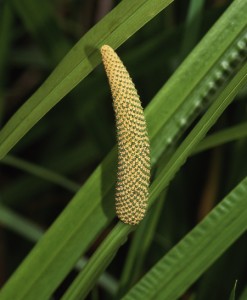Calamus root
By Ken Moore
Last week, I saw calamus root, Acorus calamus, growing wild on the edge of town in an open field with a spring flowing from the base of a big tree making a wet meadow habitat, ideal for calamus root.
Also called sweet flag, the foliage resembles the fan of flat, narrow leaves typical of blue flag irises, thus the name sweet flag. Calamus, a useful herb, is sweet tasting, while irises are poisonous. You definitely do not want to confuse the two!
Betsy Green Moyer’s photograph in Paul Green’s Plant Book was captured at the N.C. Botanical Garden. Though lacking flower petals, with a closer look the calamus flower spike is strikingly beautiful. It’s similar to Jack-in-the-Pulpit, without the hooded wrap-around sheath.
Paul Green describes sweet flag as helpful for stomach troubles and colic. It’s also reputed to be a fine stimulant, valuable for liver health and smoking cessation.
I love Green’s story “Too Late for Old Miss Minty.†The story goes: “I remember old Miss Minty who used to come and stay with us on a visit, how she would carry some sweet flag root wrapped up in her old handkerchief. And sometimes as she sat by the winter fire, she would take out the root in her trembling hands, break off a piece, put it in her toothless mouth, and sit there sucking it and staring peacefully at the fire. The root was supposed to be good for the preservation of the teeth and as an aphrodisiac, though too late to do old Miss Minty any good in either case.â€
I’ve learned from local herbalist and wildcrafter Will Endres at the Carrboro Farmers’ Market that calamus is an esteemed herbal plant. He has been working on a book all about calamus and plans to have it published later this year.
I went by the market this week to share with him my excitement about seeing it for the first time in the wild. Since he was busy with other folks, I engaged his son, Sean, himself an experienced herbalist and wildcrafter. I was impressed when Sean pulled a good-sized piece of calamus root from his pocket. He described that he chews a bit of it before cross-country races, using it like the Native Americans for long-distance endurance. Sean likes the name “singer’s root,†attributed to its value for voice projection and preventing laryngitis.
When I checked on calamus in the current taxonomic authority, I discovered that the one we find in North Carolina is the European calamus, brought over by the first European settlers. American calamus, Acorus americanus, though widespread throughout northeastern America, is not well documented, so botanists are keeping a keen eye on finding new populations of both species. The leaf of the more common European calamus has a very prominent, raised mid-vein along the middle of each leaf. The leaf of native calamus is smooth to the touch.
Calamus is in flower right now, so be certain to take that closer look when exploring open wet habitats, and remember not to confuse calamus with poisonous iris.




Comments are closed.